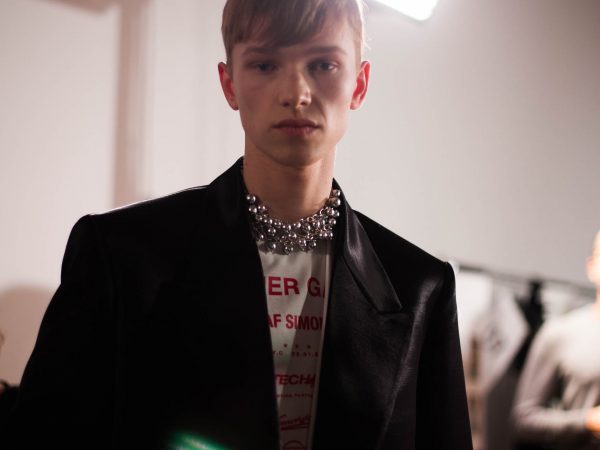The jewelry designer discusses dropping out of fashion school, discovering jewelry, and his latest partnership.
Brazilian-born, London-based jewelry designer Alan Crocetti doesn’t follow trends, nor does he follow the current beat of the jewelry industry. During his studies in womenswear design at Central Saint Martins, Crocetti developed a distinct interest for jewelry, and decided to drop out of the prestigious fashion school to pursue his newfound dream. Crocetti presented his debut collection under the Fashion East umbrella in 2015. He was, later on, picked up by Benjamin Huseby and Serhat Isik of GmbH to produce a limited selection of earrings and silver accessories for the Berlin-based fashion house.
Crocetti’s work stands out in the field of contemporary jewelry designers thanks to his heretical approach to timeless pieces. They are never boring, nor minimalistic. The jewelry consists of noble metals embellished with semi-fine stones, and embodies the gender-fluid nature of contemporary jewelry. Ear cuffs, earrings, rings, and necklaces are delicate to the eye but robust, unique, and modern. During this season’s New York Fashion Week, Crocetti added another collaboration to his resume—with none other than Helmut Lang. Document sat down with Crocetti to discuss dropping out of college, his Brazilian roots, and his latest partnership.
Above The Fold

Escapism Revived: Backstage London Fashion Week Men’s Spring/Summer 2018

The Search for the Spirit of Miss General Idea

The Game Has Changed: Backstage New York Fashion Week Men’s Autumn/Winter 2017

Adorned and Subverted: Backstage MB Fashion Week Tbilisi Autumn/Winter 2017
Madeleine Holth—I understand you grew up in Belo Horizonte, Brazil?
Alan Crocetti—It was a very amazing childhood, back when kids used to go to the streets to play and there were barely any virtual activities. I was a very curious kid and a big-time dreamer. I would venture [into] whatever I felt like, even if I would quit and start something else months later. My parents always supported me in whatever I wanted to do creatively and I grew up in a pretty united household—that’s a privilege. I came out when I was 16 and my dad’s first words were, ‘I promise you, you will never find prejudice in this house.’ That made me a lot of stronger to face the world.
Madeleine—Do you remember your first encounter with fashion?
Alan—My parents had a knitwear factory so I grew up in it playing with swatches dressing up action figures, a real cliché fashion designer childhood. However, I didn’t really think I would work in fashion. I wanted to be a plastic surgeon at some point, taking that I’m very into surrealism—let’s say it’s good I didn’t pursue that.
Madeleine—How has Brazil influenced you and your work?
Alan—The Pampulha region of Belo Horizonte, where I grew up, was where the architect Oscar Niemeyer and Landscape architect Burle Marx developed some buildings prior to the construction of the capital, Brasilia. Being in touch with that and also nature influenced me not only as a designer but as a person. My collection Odyssey was heavily influenced by those two Brazilian modernists.
Madeleine—When and why did you decide to relocate to London?
Alan—My parents went bankrupt just when I started studying fashion in Brazil. I couldn’t carry on studying there in a pretty expensive university whilst seeing everything they built fall apart right in front of me. I had plans to go to Europe at some point but that just speeded things up. I’m the oldest of three brothers, and I figured I could start working. They needed more support than me. With my Italian citizenship, I could go to the university I wanted to go in the first place, which was Central Saint Martins, in the city I had always dreamt of living in, London.
Madeleine—You decided to drop out of college right before graduation. Why did you do that?
Alan—I had some issues with some papers and I wasn’t really getting my student loan, so I had to start working full time. It happens that I was late for my final crit[ique], and my tutor at the time said that even though I had a good collection, because of my lateness I would no longer take part in the internal fashion show, but I could still finish everything and get my degree. I didn’t spend all these years there for a piece of paper, so without the show, I really wasn’t interested. We are designers—it’s all about the work, not the grades.
Madeleine—What triggered your interest in jewelry design?
Alan—I’ve always wanted to design everything and have my hands in literally whatever I could make. That was also my downfall during the CSM final collection, because I was also designing all the accessories and jewelry for the show. But it was also my ray of light. Had I not made the jewelry for the collection I would probably be doing something else right now. Apart from the fact that I love jewelry, I really fell in love with the whole process, the challenge of it, and how little people pay attention to something so exciting. I refused to see jewelry as a supporting role, and still do. My jewelry can be worn with literally everything from basic tees to black tie or ball gowns.
Madeleine—Can you tell me how you came to work with Helmut Lang?
Alan—They contacted me as soon as I got back from Paris Fashion week this January, and we got things going [immediately]. Mark Thomas and Thomas Cawson were just starting this new Helmut era and I was incredibly grateful, honored, and excited to be a part of it. Mark, Thomas, and the stylist Carlos Nazario are such a dream team.
Madeleine—How does this collection differ from other collaborations you’ve done in the past?
Alan—In every [previous] collaboration, I have the privilege of [working] on the ideas and give my own take based on the brand’s mood board. For Helmut Lang, it was literally my brand integrated into their show.









